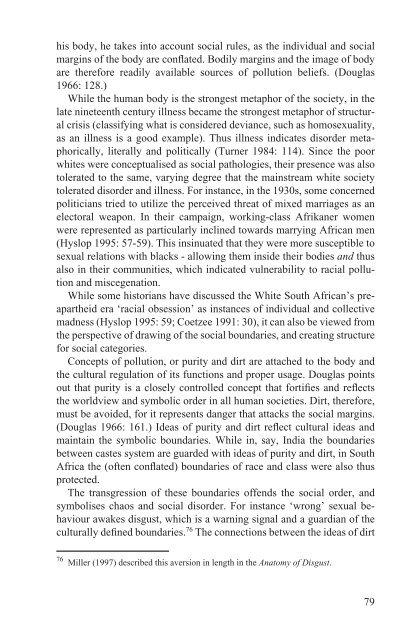The Making of a Good White - E-thesis - Helsinki.fi
The Making of a Good White - E-thesis - Helsinki.fi
The Making of a Good White - E-thesis - Helsinki.fi
Create successful ePaper yourself
Turn your PDF publications into a flip-book with our unique Google optimized e-Paper software.
his body, he takes into account social rules, as the individual and social<br />
margins <strong>of</strong> the body are conflated. Bodily margins and the image <strong>of</strong> body<br />
are therefore readily available sources <strong>of</strong> pollution beliefs. (Douglas<br />
1966: 128.)<br />
While the human body is the strongest metaphor <strong>of</strong> the society, in the<br />
late nineteenth century illness became the strongest metaphor <strong>of</strong> structural<br />
crisis (classifying what is considered deviance, such as homosexuality,<br />
as an illness is a good example). Thus illness indicates disorder metaphorically,<br />
literally and politically (Turner 1984: 114). Since the poor<br />
whites were conceptualised as social pathologies, their presence was also<br />
tolerated to the same, varying degree that the mainstream white society<br />
tolerated disorder and illness. For instance, in the 1930s, some concerned<br />
politicians tried to utilize the perceived threat <strong>of</strong> mixed marriages as an<br />
electoral weapon. In their campaign, working-class Afrikaner women<br />
were represented as particularly inclined towards marrying African men<br />
(Hyslop 1995: 57-59). This insinuated that they were more susceptible to<br />
sexual relations with blacks - allowing them inside their bodies and thus<br />
also in their communities, which indicated vulnerability to racial pollution<br />
and miscegenation.<br />
While some historians have discussed the <strong>White</strong> South African’s preapartheid<br />
era ‘racial obsession’ as instances <strong>of</strong> individual and collective<br />
madness (Hyslop 1995: 59; Coetzee 1991: 30), it can also be viewed from<br />
the perspective <strong>of</strong> drawing <strong>of</strong> the social boundaries, and creating structure<br />
for social categories.<br />
Concepts <strong>of</strong> pollution, or purity and dirt are attached to the body and<br />
the cultural regulation <strong>of</strong> its functions and proper usage. Douglas points<br />
out that purity is a closely controlled concept that forti<strong>fi</strong>es and reflects<br />
the worldview and symbolic order in all human societies. Dirt, therefore,<br />
must be avoided, for it represents danger that attacks the social margins.<br />
(Douglas 1966: 161.) Ideas <strong>of</strong> purity and dirt reflect cultural ideas and<br />
maintain the symbolic boundaries. While in, say, India the boundaries<br />
between castes system are guarded with ideas <strong>of</strong> purity and dirt, in South<br />
Africa the (<strong>of</strong>ten conflated) boundaries <strong>of</strong> race and class were also thus<br />
protected.<br />
<strong>The</strong> transgression <strong>of</strong> these boundaries <strong>of</strong>fends the social order, and<br />
symbolises chaos and social disorder. For instance ‘wrong’ sexual behaviour<br />
awakes disgust, which is a warning signal and a guardian <strong>of</strong> the<br />
culturally de<strong>fi</strong>ned boundaries. 76 <strong>The</strong> connections between the ideas <strong>of</strong> dirt<br />
76 Miller (1997) described this aversion in length in the Anatomy <strong>of</strong> Disgust.<br />
79
















